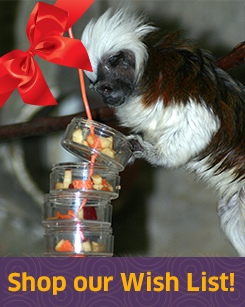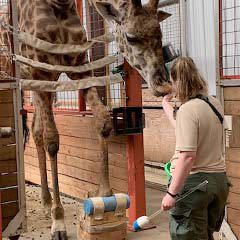Otto Enrichment Animal Care Products
• Please review our current Health & Safety Updates ( FPZ and SZ ) before your visit.
• Non-Members: Online reservations are required for admission tickets.
• Members: Advance reservations for daytime admission are not required.
x

Hyacinth Macaw
Animal Care

It's not an egg carton. It's a game of hide-and-seek.
It's not a log. It's an obstacle course.
It's not a toy. It's animal enrichment.
Animals in the wild spend much of their time and energy finding food, building homes, defending their territories and escaping predators. Zoo life is more predictable, as most animals' resources are provided for them. It's our job to offer them creative ways to use that energy—that's where enrichment comes in.
What's enrichment?
Environmental enrichment encourages animals to use their natural abilities and behaviors to interact with their environment. By examining the way an animal acts in its natural environment, we can recreate similar situations here at the Zoo. Whether an animal likes to stalk and chase its prey, burrow underground to hide, or forage for food, its behavior is taken into consideration when creating enrichment.
 Our Enrichment Committee
Our Enrichment Committee
Zoo New England's Enrichment Committee, made up of an experienced team of zookeepers, meets monthly to evaluate current forms of enrichment and create new ones. A larger network of Zoo staff, including curators, veterinarians and the horticulture team also play a role in enrichment planning.
Types of Enrichment:
Those out-of-place items you may see in exhibits aren't there by mistake: they play a key role in stimulating our animals and exciting the senses. Enrichment can be offered through the following ways:
Training: Try and try again!
Animal training programs play a valuable role by providing animals with choices and mental challenges. We train many of our animals, including gorillas, giraffes, otters, parrots, jaguars, and even the goats.
Training through positive reinforcement and operant conditioning allows animals to voluntarily participate in activities that challenge them to think and learn new things in exchange for a favorite treat.
Here at Zoo New England, we practice protected contact with our animals. For keepers' safety, a protective barrier separates them from most animals at all times.
Animals are trained not only in husbandry behaviors that assist keepers in daily care, but also in medical behaviors to help hospital staff with veterinary care. This type of training is significant because it allows animals to be examined without having to be sedated, which can be stressful and sometimes even dangerous.
Physical: Leaping, swimming and swinging
During your visit, you'll see hammocks, tire swings, ropes, perches and climbing structures. This is to encourage an active lifestyle similar to animals' natural environments. Look for pools and mud holes for swimming and cooling down. See if you can spot our animals batting boomer balls—"toys" made to withstand the jaws and claws of zoo animals—egg cartons, or paper maché piñatas.
Food: Scattering, smearing and puzzling
Rather than simply filling a food bowl, zookeepers scatter, smear, freeze or hide meals to encourage animals to forage, hunt and manipulate their food, as they would in the wild. Specialized "puzzle feeders" have holes throughout, allowing food to fall out as animals manipulate the feeder, encouraging them to investigate and problem-solve.
Social interactions like feeding, playing, grooming, courting, rearing young or marking territory are important components of many animals' lives. Exhibits are designed to provide social enrichment by appropriately pairing or grouping animals, including mixed species, and making private spaces available for animals to retreat from each other and the public.
For example, prairie dogs have a complex social system composed of one male and several females and their offspring. Highly-social prairie dogs live in large colonies of families that can span hundreds of acres. They dig well-constructed burrows with side chambers for storage, nesting and escape from predators or flooding.
Sensory: Sniffing, howling and nesting
Most animals have highly developed sensory abilities. Keen eyesight helps predators find prey. Acute hearing can detect an impending threat. Some animals use their sense of taste for bonding with young. Smells are important for marking and recognizing territories.
Sensory enrichment can be provided in various ways:
- Spices, perfumes and animal scents
- Different textures such as straw, soft blankets, paper and wood shavings
- Playing recordings of animal vocalizations or other nature sounds
- Placing elevated platforms and perches to allow visual access to other exhibits, animals and activities
- Incorporating simulated prey items into predator exhibits to encourage stalk and chase behaviors
In the wild, gorillas make nests out of leaves and branches every night to sleep. Our gorillas love to cover themselves with blankets and will also make nests out of hay or paper for taking mid-day naps.
Otto Enrichment Animal Care Products
Source: https://www.zoonewengland.org/protect/inside-our-zoos/animal-care/
0 Response to "Otto Enrichment Animal Care Products"
Post a Comment